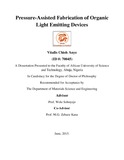| dc.description.abstract | This dissertation presents an overview of the research work with the above caption. This research is divided into five major sections or parts. Part one deals with interfacial adhesion studies of the layers relevant to organic light-emitting diodes (OLEDs). The adhesion interactions, that is, force and energy between different interfaces of the adjacent layers relevant to the OLED structure used in this work are analyzed together with their implication(s) on the device performance.
In the second part of the research, we use nanoindentation techniques to determine the mechanical properties of the OLED layers. These properties are utilized in computational models essential to validate the experimental results. Pressure-assisted fabrication of OLEDs is described in the third section of the research. It was noticed from the experimental and finite element analyses that the application of pressure on finished OLEDs has the potential to improve their performance.
Electrical characterization of the devices fabricated with molybdenum trioxide (MoO3) and poly[3,4-ethylenedioxythiophene]: poly(styrene sulfonate) (PEDOT:PSS) as hole injection layer materials (HILMs) show a 50% reduction in turn-on voltage when the devices are compressed.
MoO3-based devices without pressure application revealed lower turn-on voltages without pressure than PEDOT: PSS-based. This implies that MoO3 represents a better HILM than PEDOT: PSS. The fourth part of this work is concerned with an attempt to prolong the life of these devices. This is achieved through encapsulation with the use of polydimethyl siloxane (PDMS). This encapsulation process has the potential to tune the optical properties of the material layers. Optical simulations using COMSOL Multiphysics ver. 4.3 finite element analysis software package is used to better capture the effect of this change in optical properties on the diffusion of the light produced by the device. In the last part of this research, we will
employ more cost-effective and temperature friendly techniques through soft-contact lamination to deposit some of the layers relevant to OLEDs.
A fracture mechanics approach is used to analyze the differential adhesion energy and energy release rate during pull-off of the stamp
material used as anvil. | en_US |

